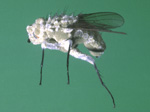Evaluation of entomopathogenic fungi for the control of the cabbage root fly
In Defra funded research, we investigated entomopathogenic fungi to control larvae of the cabbage root fly, Delia radicum (Diptera, Muscidae, subf. Anthomyiidae). This is the most important pest of horticultural brassicas. The larvae feed on plant roots and reduce the yield and quality of the crop.
Cabbage root fly control has relied on the use of organophosphate and carbamate insecticides, however brassica growers are under intense pressure to reduce or stop using chemical insecticides because of consumer concerns about pesticide residues. Alternatives to chemicals are required urgently, therefore, including microbial control agents.
We developed a lab bioassay to measure fungal virulence against larvae of the closely related onion fly, Delia antiqua. We found that cabbage root fly larvae did not respond well to bioassay conditions, so instead we used onion fly larvae as a model organism.
We screened c. 100 isolates of fungi against third instar D. antiqua larvae, and identified two isolates of Metarhizium anisopliae which showed promising levels of virulence. Generally, the larvae had a low level of susceptibility to fungi; in contrast the adults were highly susceptible and died quickly.
In glasshouse experiments, treating the plants with a fungal drench application significantly reduced the number of larvae, pupae and emerging adults. One strain of M. anisopliaereduced the cabbage root fly population by up to 90%.
We also investigated the effect of fungicides, used on brassica crops, on fungal activity. While the fungicides were inhibitory to the fungal isolates in vitro, the two selected fungicides were not detrimental to M. anisopliae in the glasshouse.
While M. anisopliae controlled populations of cabbage root fly larvae in the glasshouse, there was no significant effect against natural colonisation of cauliflower plants by cabbage root fly in a field experiment. Conidia applied to soil did not move far below the soil surface, and we suspect therefore that this may have prevented conidia from reaching cabbage root fly larvae in the field. Further work is required to develop an effective soil application strategy.
Selected references:
CHANDLER, D. & DAVIDSON, G. (2005). Evaluation of the entomopathogenic fungus Metarhizium anisopliae against soil dwelling stages of the cabbage maggot, Delia radicum (L.) (Diptera: Anthomyiidae), in glasshouse and field experiments, and the effect of fungicides on fungal activity. Journal of Economic Entomology, 98, 1856 – 1862.
DAVIDSON, G. & CHANDLER, D. (2005). Laboratory evaluation of entomopathogenic fungi against larvae and adults of the onion maggot (Diptera: Anthomyiidae). Journal of Economic Entomology, 98, 1848-1855.

Cabbage root fly infected by Metarhizium
